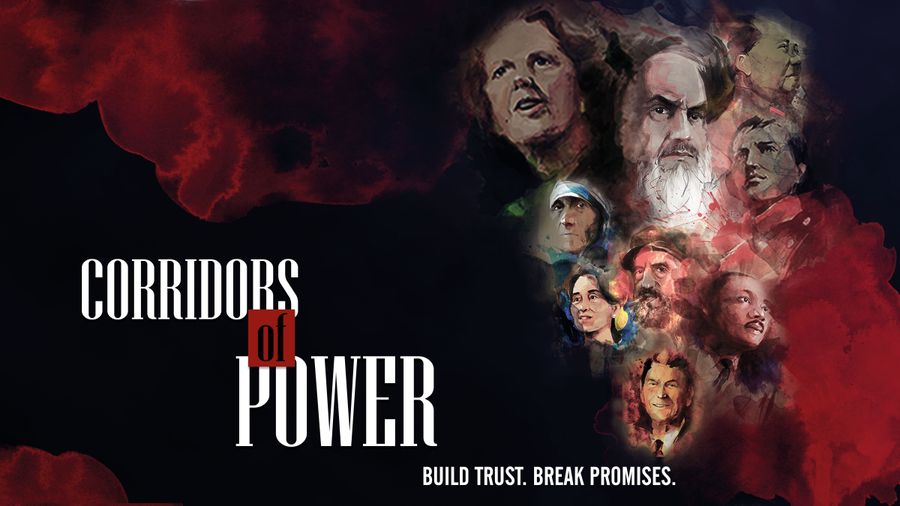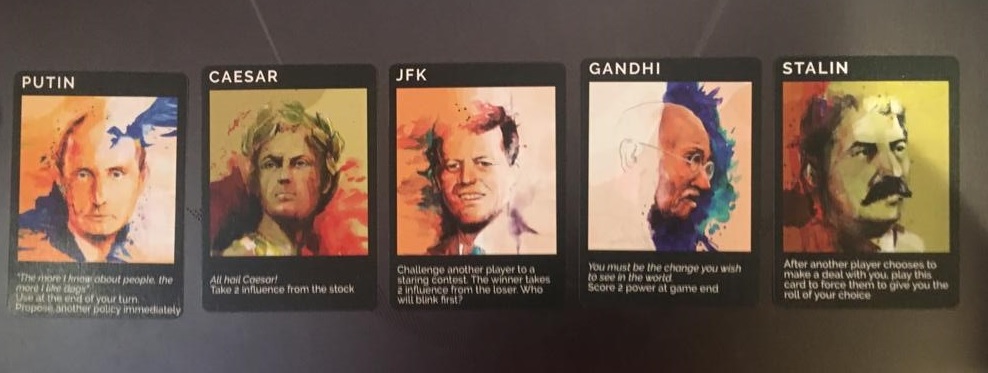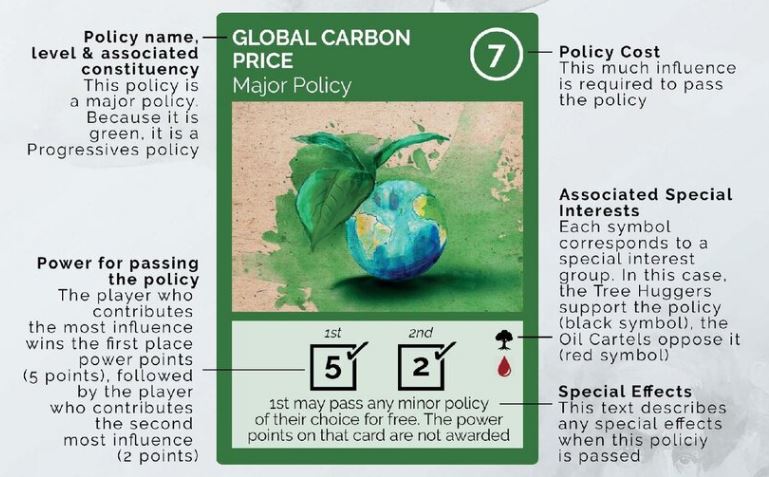Corridors of Power
Corridors of Power is a social game on the heavier side, with a political theme

Posted 14 September 2020 by Jay Kay
- Designer(s): Nick Bailey & Lewis Bailey
- Publisher: Bailey Bros Boardgames
- Playercount: 3-6
- Length: 60-90 min
- Age: 12+
Corridors of Power is a social game on the heavier side, with a political theme, in which players are trying to please their constituents and behind-the-scenes special interest groups by passing different political policies. Sounds like fun? It sure is; read on.
Components
- 3 x policy board dividers
- 30 policy cards
- 30 constituents cards
- 32 cabinet member cards
- 13 political crisis cards
- 17 special interests cards
- 50 influence tokens
- 18 smear tokens
- 6 x 10 player cubes
- rule book
- 2 white deal-making dice (for 3-4 players)
- 2 black deal-making dice (for 5-6 players)
Setup
Each player will receive 5 random constituent cards, and these are essentially the ones you must please with your politics. There are 3 different kinds, red, blue, and greens. You can probably guess that these represent the workers, big business, and the progressives respectively.
Then, players will be given 2 special interest cards, and you will be doing everything to please these groups to gain power (points). Of these two cards, players will choose one, so it's a good idea to chose one that goes hand-in-hand with the constituents cards you have been dealt. Finally, each player will be dealt 2 cabinet member cards, which special powers usable throughout the game. These cabinet members range from classic leaders figures like Nelson Mandela and Gandhi to more controversial ones like Khomeini and Stalin. Each player is also given 10 player cubes in a color of their choice, 2 yellow influence tokens, and 1 smear token.
Now that the player setup is done, you will sort the 30 different policies into rows, starting with the 6 headline policies, and after that, you will overlap that row with the 6 major and finally 18 minor policies. This is called the policy landscape.
Then, put the cabinet members and political crisis stacks face down close to the policies. The final part of the setup is to pick the right pair of deal-making dice; The white dice are for games with 3-4 players, and the black dice is for games with 5-6 players. That's it, setup should take you no more than 5 minutes.

Gameplay
When it's your turn, you will first decide which fellow player you want to make a deal with. Probably one you suspect has similar in-game interest as you. Then you will roll the two deal-making dice and take one for yourself and give the other one to the player you chose. Both players receive the resources indicated on the dice. This can be influence, smear, cabinet member cards, and the ability to move a policy from the the policy landscape to the policy wasteland, where it cannot be voted on. You can also use this to do the vice-versa.
Then, you will enter the Policy proposal phase. You will pick a policy from the policy landscape that is not overlapped by another policy and every player must cast a vote by secretly contributing influence and/or smear. It is also possible not to contribute anything. At this point, you will discuss with your fellow players and trying to convince them to vote as you want them to, and players might make promises and break them, just like the dirty politician you are. All good fun.
When everyone is ready, they simultaneously reveal their votes, and if the influence is enough, the policy will pass. Note that smear will count as negative influence.
Each policy has a policy cost, an influence threshold that must be satisfied in order for the policy to pass. These can range from 4 for the minor policies and 8 for the headline policies. If the policy does not pass, it goes to the policy wasteland, and if it passes, the player that contributed the most will place a cube on the 1st player score, and the player who contributed the second most will score the 2nd spot. There are usually 2 or 3 such spaces on each card.

Gameplay will continue in this fashion until 2 of the headline policies have been proposed, and then each player gets one more turn, after that the game ends.
Game End and Scoring
First, each player scores the points on the policy cards they contributed to like stated above, and then they will score the special interest cards. Typically, these cards reward you if certain policies have passed, and punishes you if certain other policies have passed.
After that, constituents are scored. To do this, count the number of passed policies of each color. The policy with the highest number is the winning color, followed by the color that has the 2nd highest number of policies passed. Players will now score 3 points per constituent card they have of the winning type and 1 point each for the runner-up. Note that these points may be boosted by passing certain policies.
Finally, players might have cabinet member cards that score points. The winner is surprisingly enough the player with the most Power (points).
OPINION
The good
- A unique blend of social and strategy, a party game on the heavier side, if you will.
- Very tense.
- A lot of surprises and twists thanks to the combination of the voting system and cabinet members card.
- Very cut-throat.
- Very nice artwork and components.
The bad
- A bit lengthy, it takes around 90 minutes to play.
- Very cut-throat. This can be remedied to some degree by simple variants though.
CONCLUSION
Corridors of Power delivers what it promises; a social game with strategic depth. To win, you must truly be like a politician, make allies, and break deals at the right time, preferably playing the other players against each other while you sneak the policies you want pass voting, while you must control your resources in form of influence, smear, and cabinet member cards.
If you can find a group of people who would enjoy a game like that this is perfect since there are very few games like this on the market. Be warned though, it is cut-throat which might be a good thing and a bad thing depending on the group of people you play with.
To sum it up, a very interesting, fun, and merciless social game on the heavier side. 7/10
I want to thank the Bailey Brother for sending me a copy to review. This game will be Kickstarted later this year. We will let you know when. Meanwhile, you can buy the game at www.corridorsofpower.com.au/
Return to Reviews